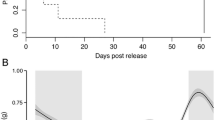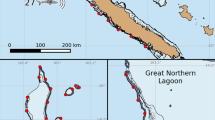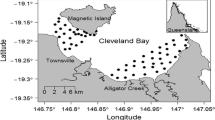Abstract
A review of past behavioral ultrasonic telemetry studies of sharks and rays is presented together with previously unpublished material on the behavior of the lemon shark, Negaprion brevirostris, around the Bimini Islands, Bahamas. The review, focusing on movement behaviors of 20 shark and three ray species, reveals that elasmobranchs exhibit a variety of temporal and spatial patterns in terms of rates-of-movement and vertical as well as horizontal migrations. The lack of an apparent pattern in a few species is probably attributable to the scarcity of tracking data. Movements are probably governed by several factors, some still not studied, but data show that food, water temperature, bottom type, and magnetic gradient play major roles in a shark's decision of where and when to swim. A few species exhibit differences in behavior between groups of sharks within the same geographical area. This interesting finding warrants further research to evaluate the causes of these apparent differences and whether these groups constitute different subpopulations of the same species. The lack of telemetry data on batoids and some orders of sharks must be addressed before we can gain a more comprehensive understanding of the behavior of elasmobranch fishes. Previously unpublished data from 47 smaller and 38 larger juvenile lemon sharks, collected over the decade 1988–1998, provide new results on movement patterns, habitat selection, activity rhythms, swimming speed, rate-of-movement, and homing behavior. From these results we conclude that the lemon shark is an active predator with a strong, apparently innate homing mechanism. This species shows ontogenetic differences in habitat selection and behavior, as well as differences in movements between groups of individuals within the same area. We suggest three hypotheses for future research on related topics that will help to understand the enigmatic behavior of sharks.
Similar content being viewed by others
References
Ackerman, J.T., M.C. Kondratieff, S.A. Matern & J.J. Cech. 2000. Tidal influence on spatial dynamics of leopard sharks, Triakis semifasciata, in Tomales Bay, California. Env. Biol. Fish. 58: 33–43.
Alcock, J. 1993. Animal behavior. Sinauer Associates, Sunderland. 625 pp.
Anderson, S.D. & K.J. Goldman. 1996. Photographic evidence of white shark movements in California waters. Calif. Fish. Game 82: 182–186.
Bass, G.A. & M. Rascovich. 1965. Adevice for the sonic tracking of large fishes. Zoologica 50: 75–83.
Bathurst, R.G.C. 1967. Ölitic films on lowenergy carbonate sand grains, Bimini Lagoon, Bahamas. Mar. Geol. 5: 89–109.
Becker, J.B, S.M. Breedlove & D. Crews. 1992. Behavioral endocrinology. The MIT Press, Cambridge. 574 pp.
Blaylock, R.A. 1990. Effects of external biotelemetry transmitters on behavior of the cownose ray Rhinoptera bonasus (Mitchill 1815). J. Exp. Mar. Biol. Ecol. 141: 213–220.
Bone, Q. 1988. Muscles and locomotion. pp. 99–141. In: T.J. Shuttleworth (ed.) Physiology of Elasmobranch Fishes, Springer-Verlag, Berlin.
Bradbury, J.W. & S.L. Vehrencamp. 1998. Principles of animal communication. Sinauer Associates, Sunderland. 882 pp.
Brown, C.A. & S.H. Gruber. 1988. Age assessment of the lemon shark, Negaprion brevirostris, using tetracycline validated vertebral centra.Copeia 1988: 747–753.
Bushnell, P.G., P.L. Lutz & S.H. Gruber. 1989. The metabolic rate of an active, tropical elasmobranch, the lemon shark (Negaprion brevirostris). Exp. Biol. 48: 279–283.
Carey, F.G. & E. Clark. 1995. Depth telemetry from the sixgill shark, Hexanchus griseus, at Bermuda. Env. Biol. Fish. 42: 7–14.
Carey, F.G. & Q.H. Gibson. 1987. Blood flow in the muscle of free-swimming fish. Physiol. Zool. 60: 138–148.
Carey, F.G. & B.H. Robinson. 1981. Daily patterns in the activities of swordfish, Xiphias gladius, observed by acoustic telemetry. U.S. Fish. Bull. 79: 277–292.
Carey, F.G. & J.V. Scharold. 1990. Movements of blue sharks (Prionace glauca) in depth and course. Mar. Biol. 106: 329–342.
Carey, F.G., J.W. Kanwisher, O. Brazier, G. Gabrielson, J.G. Casey & H.L. Pratt, Jr. 1982. Temperature and activities of a white shark, Carcharodon carcharias. Copeia 1982: 254–260.
Carey, F.G., J.M. Teal & J.W. Kanwisher. 1981. The visceral temperatures of mackerel sharks (Lamnidae). Physiol. Zool. 54: 334–344.
Casey, J.G. & N.E. Kohler. 1990. Long distance movements of Atlantic sharks from the NMFS cooperative shark tagging program. pp. 87–91. In: S.H. Gruber (ed.) Discovering Sharks, Underwater Naturalist, Highlands.
Cohen, J.L. 1991. Adaptations for scotopic vision in the lemon shark. J. Exp. Zool. suppl. 5: 76–84.
Compagno, L.J.V. 1984. FAO species catalogue of the world, vol 4: Sharks of the world. An annotated and illustrated catalogue of shark species known to date, part 2: Carcharhiniformes. FAO Fish. Synop. 125, Vol. 4, Pt.2: 251–665.
Cortés, E. & S.H. Gruber. 1990. Diet, feeding habits and estimates of daily ration of young lemon sharks, Negaprion brevirostris (Poey). Copeia 1990: 204–218.
Cort73x00E9;s, E. & S.H. Gruber. 1994. Effect of ration size on growth and gross conversion efficiency of young lemon sharks, Negaprion brevirostris. J. Fish Biol. 44: 331–341.
Economakis, A.E. & P.S. Lobel. 1998. Aggregation behavior of the grey reef shark, Carcharhinus amblyrhynchos, at Johnston Atoll, Central Pacific Ocean. Env. Biol. Fish. 51: 129–139.
Garrick, J.A.F. & L.P. Schultz. 1963. A guide to the kinds of potentially dangerous sharks. pp. 3–60. In: P.W. Gilbert (ed.) Sharks and Survival, D. C. Heath, Boston.
Gero, D.R. 1952. The hydrodynamic aspects of fish propulsion. Amer. Mus. Novitates 1601: 1–32.
Goldman, K.J., S.D. Anderson, J.E. McCosker & A.P. Klimley. 1996. Temperature, swimming depth, and movements of a white shark at the South Farallon Islands, California. pp. 111–120. In: A.P. Klimley & D.G. Ainley (ed.) Great White Sharks: The Biology of Carcharodon carcharias, Academic Press, San Diego.
Goldman, K.J. & S.D. Anderson. 1999. Space utilization and swimming depth of white sharks, Carcharodon carcharias, at the South Farallon Islands, central California. Env. Biol. Fish. 56: 351–364.
Goodenough, J., B. McGuire & R.A. Wallace. 1993. Perspectives on animal behavior. John Wiley & Sons, New York. 762 pp.
Graham, J.B., H. Dewar, N.C. Lai, W.R. Lowell & S.M. Arce. 1990. Aspects of shark swimming performance determined using a large water tunnel. J. Exp. Biol. 151: 175–192.
Gruber, S.H. 1982. Role of the lemon shark, Negaprion brevirostris (Poey) as a predator in the tropical marine environment: a multidisciplinary study. Florida Sci. 45: 4–75.
Gruber, S.H. & J.S. Cohen. 1978. Vision in sharks. pp. 11–105. In: E. Hodgson & R. Mathewson (ed.) Sensory Biology of Sharks, Skates, and Rays, Off. Naval Res., Arlington.
Gruber, S.H., D.R. Nelson & J.F. Morrissey. 1988. Patterns of activity and space utilization of lemon sharks, Negaprion brevirostris, in a shallow Bahamian lagoon. Bull. Mar. Sci. 43: 61–76.
Gunn, J.S., J.D. Stevens, T.L.O. Davis & B.M. Norman. 1999. Observations on the short-term movements and behaviour of whale sharks (Rhincodon typus) at Ningaloo Reef, Western Australia. Mar. Biol. 135: 553–559.
Hamilton, W. J. & K. E. Watts. 1970. Refuging. Ann. Rev. Ecol. Syst. 1: 263–287.
Helfman, G.S. 1993. Fish behaviour by day, night and twilight. pp. 479–512. In: T.J. Pitcher (ed.) Behaviour of Teleost Fishes, Chapman & Hall, London.
Holland, K.N., C.G. Lowe, J.D. Peterson & A. Gill. 1992. Tracking coastal sharks with small boats: hammerhead shark pups as a case study. Aust. J. Mar. Freshwat. Res. 43: 61–66.
Holland, K.N., B.M. Wetherbee, C.G. Lowe & C.G. Meyer. 1999. Movements of tiger sharks (Galeocerdo cuvier) in coastal Hawaiian waters. Mar. Biol. 134: 665–673.
Holland, K.N., B.M. Wetherbee, J.D. Peterson & C.G. Lowe. 1993. Movements and distribution of hammerhead shark pups on their natal grounds. Copeia 1993: 495–502.
Holts, D.B. & D.W. Bedford. 1993. Horizontal and vertical movements of the shortfin mako shark, Isurus oxyrinchus, in the southern California Bight. Aust. J. Mar. Freshwat. Res. 44: 901–909.
Huish, M.T. & C. Benedict. 1978. Sonic tracking of dusky sharks in the Cape Fear River, North Carolina. J. Elisha Mitchell Scien. Soc. 93: 21–26.
Kalmijn, A.J. 1978. Experimental evidence of geomagnetic orientation in elasmobranch fishes. pp. 347–353. In: K. Schmidt- Koenig & W.T. Keeton (ed.) Animal Migration, Navigation, and Homing, Springer-Verlag, Heidelberg.
Kalmijn, A.J. 1988. Detection of weak electric fields. pp. 151–186. In: A.J. Kalmijn, J. Atama, R.R. Fay, A.N. Popper & W.N. Tavola (ed.) Sensory Biology of Aquatic Animals, Springer-Verlag, Heidelberg.
Klimley, A.P. 1993. Highly directional swimming by scalloped hammerhead sharks, Sphyrna lewini, and subsurface irradiance, temperature, bathymetry, and geomagnetic field. Mar. Biol. 117: 1–22.
Klimley, A.P. & S.B. Butler. 1988. Immigration and emigration of a pelagic fish assemblage to seamounts in the Gulf of California related to water mass movements using satellite imagery. Mar. Ecol. Prog. Ser. 49: 11–20.
Klimley, A.P., S.B. Butler, D.R. Nelson & A.T. Stull. 1988. Diel movement of scalloped hammerhead shark, Sphyrna lewini Griffith and Smith, to and from a seamouth in the Gulf of California. J. Fish Biol. 33: 751–761.
Klimley, A.P., I. Cabrera-Mancilla & J.L. Castillo-Geniz. 1993. Horizontal and vertical movements of the scalloped hammerhead shark, Sphyrna lewini, in the southern Gulf of California, Mexico. Ciencias Marinas 19: 95–115.
Klimley, A.P. & D.R. Nelson. 1984. Diel movement patterns of the scalloped hammerhead shark (Sphyrna lewini) in relation to El Bajo Espiritu Santo: a refuging central-position social system. Behav. Ecol. Sociobiol. 15: 45–54.
Lowe, C.G. & K.J. Goldman. 2001. Thermal and bioenergetics of elasmobranchs: bridging the gap. Env. Biol. Fish. 60: 251–266.
Lowe, C.G., K. N. Holland & T.G. Wolcott. 1998. A new acoustic tail beat transmitter for fishes. Fish. Res. 36: 275–283.
Major, P.F. 1977. Predator-prey interactions in schooling fishes during periods of twilight: a study of the silverside Pranesus insularum in Hawaii. U.S. Fish. Bull. 75: 425–426.
Matern, S.A., J.J. Cech & T.E. Hopkins. 2000. Diel movements of bat rays, Myliobatis californica, in Tomales Bay, California: evidence for behavioral thermoregulation? Env. Biol. Fish. 58: 171–180.
McCosker, J.E. 1987. The white shark, Carcharodon carcharias, has a warm stomach. Copeia 1987: 195–197.
McKibben, J.N. & D.R. Nelson. 1986. Patterns of movement and groupings of grey reef sharks, Carcharhinus amblyrhynchos, at Eniwetak, Marshall Islands. Bull. Mar. Sci. 38: 89–110.
Medved, R.J. & J.A. Marshall. 1983. Short-term movements of young sandbar sharks, Carcharhinus plumbeus. Bull. Mar. Sci. 33: 87–93.
Metcalfe, J.D., G.P. Arnold & P.W. Webb. 1990. The energetics of migration by selective tidal stream transport: an analysis for plaice tracked in the southern North Sea. J. Mar. Biol. Ass. U.K. 70: 149–162.
Morrissey, J.F. & S.H. Gruber. 1993a. Habitat selection by the juvenile lemon shark, Negaprion brevirostris. Env. Biol. Fish. 38: 311–319.
Morrissey, J.F. & S.H. Gruber. 1993b. Home range of juvenile lemon sharks, Negaprion brevirostris. Copeia 1993: 425–434.
Myrberg, A.A. Jr. 1976. Behavior of sharks - a continuing enigma. Nav. Res. Rev. 29: 1–11.
Nelson, D.R., J.N. McKibben, W.R. Strong, Jr., C.G. Lowe, J.A. Sisneros, D.M. Schroeder & R.J. Lavenberg. 1997. An acoustic tracking of a megamouth shark, Megachasma pelagios: a crepuscular vertical migrator. Env. Biol. Fish. 49: 389–399.
Nixon, A.J. & S.H. Gruber. 1988. Diel metabolic and activity patterns of the lemon shark (Negaprion brevirostris). J. Exp. Zool. 248: 1–6.
Parsons, G.R. & J.K. Carlson. 1998. Physiological and behavioral responses to hypoxia in the bonnethead shark, Sphyrna tiburo: routine swimming and respiratory regulation. Fish Phys. Biochem. 19: 189–196.
Priede, I.G. 1984.A basking shark (Cetorhinus maximus) tracked by satellite together with simultaneous remote sensing. Fish. Res. 2: 201–216.
Rogers, S.C., D.W. Church, A.H. Weatherly & D.G. Pincock. 1984. An automated ultrasonic telemetry system for the assessment of locomotor activity in free-ranging rainbowtrout, Salmo gairdneri Richardson. J. Fish Biol. 25: 697–710.
Scharold, J. & S.H. Gruber. 1991. Telemetered heart rate as a measure of metabolic rate in the lemon shark, Negaprion brevirostris. Copeia 1991: 942–953.
Sciarrotta, T.C. & D.R. Nelson. 1977. Diel behavior of the blue shark, Prionace glauca, near Santa Catalina Island, California. U.S. Fish. Bull. 75: 519–528.
Silliman, W.R. & S.H. Gruber. 1999. Behavioral biology of the spotted eagle ray, Aetobatus narinari (Euphrasen, 1790), in Bimini, Bahamas; an interim report. Bahamas J. Sci. 7: 13–20.
Sims, D.W. 1999. Threshold foraging behaviour of basking sharks on zooplankton: life on an energetic knife-edge? Proc. R. Soc. Lond. B 266: 1437–1443.
Standora, E.A. & D. R. Nelson. 1977. A telemetric study of the behavior of free-swimming Pacific angel sharks, Squatina californica. Bull. South. Cal. Acad. Sci. 76: 193–201.
Strong, W.R., Jr., B.D. Bruce, D.R. Nelson & R.D. Murphy. 1996. Population dynamics of white sharks in Spencer Gulf, South Australia. pp. 401–414. In: A.P. Klimley & D.G. Ainley (ed.) Great White Sharks: The Biology of Carcharodon carcharias, Academic Press, San Diego.
Strong, W.R., Jr., R.D. Murphy, B.D. Bruce & D.R. Nelson. 1992. Movements and associated observations of bait-attracted white sharks, Carcharodon carcharias: a preliminary report. Aust. J. Mar. Freshwat. Res. 43: 13–20.
SundstrÖm, L.F. & S.H. Gruber. 1998. Using speed sensing transmitters to model the bioenergetics of subadult lemon sharks, Negaprion brevirostris (Poey), in the field. Hydrobiol. 271/272: 241–247.
SundstrÖm, L.F., J. Sterk & S.H. Gruber. 1998. Effects of a speedsensing transmitter on the swimming speed of lemon sharks. Bahamas J. Sci. 6: 12–22.
Swihart, R.K. & N.A. Slade. 1985. Testing for independence of observations in animal movements. Ecology 66: 1176–1184.
Thomson, K.S. & D.E. Simanek. 1977. Body form and locomotion in sharks. Amer. Zool. 17: 343–354.
Thorson, T.B. 1971. Movement of bull sharks, Carcharhinus leucas, between the Caribbean Sea and Lake Nicaragua demonstrated by tagging. Copeia 1971: 336–339.
Tricas, T.C. & J.E. McCosker. 1984. Predatory behavior of the white shark, Carcharodon carcharias, with notes on its biology. Proc. Calif. Acad. Sci. 14: 221–238.
Tricas, T.C., L.R. Taylor & G. Naftel. 1981.Diel behavior of the tiger shark, Galeocerdo cuvier, at French Frigate Schoals, Hawaiian Islands. Copeia 1981: 904–908.
Voegeli, F.A., M.J. Smale, D.M. Webber, Y. Andrade & R.K. O'Dor. 2001. Ultrasonic telemetry, tracking and automated monitoring technology for sharks. Env. Biol. Fish. 60: 267–281.
Webb, P.W. 1984. Form and function in fish swimming. Sci. Amer. 241: 72–82.
Webb, P.W. & R.S. Keyes. 1982. Swimming kinematics of sharks. U.S. Fish. Bull. 80: 803–812.
Wiltschko, R. & W. Wiltschko. 1995. Magnetic Orientation in Animals. Springer-Verlag, Heidelberg. 297 pp.
Wood, G.L. 1982. The Guinness book of animal facts and feats. G.L.Woods and Guinness Superlatives LTD, New York. 275 pp.
Yano, K. & S. Tanaka. 1986. A telemetric study on the movements of the deep sea squaloid shark, Centrophorus acus. pp. 372–380. In: T. Uyeno, R. Arai, T. Taniuchi & K. Matsuura (ed.) Indo-Pacific Fish Biology, The Ichthyological Soc. Japan, Tokyo.
Author information
Authors and Affiliations
Rights and permissions
About this article
Cite this article
Sundström, L.F., Gruber, S.H., Clermont, S.M. et al. Review of Elasmobranch Behavioral Studies Using Ultrasonic Telemetry with Special Reference to the Lemon Shark, Negaprion Brevirostris, Around Bimini Islands, Bahamas. Environmental Biology of Fishes 60, 225–250 (2001). https://doi.org/10.1023/A:1007657505099
Issue Date:
DOI: https://doi.org/10.1023/A:1007657505099




